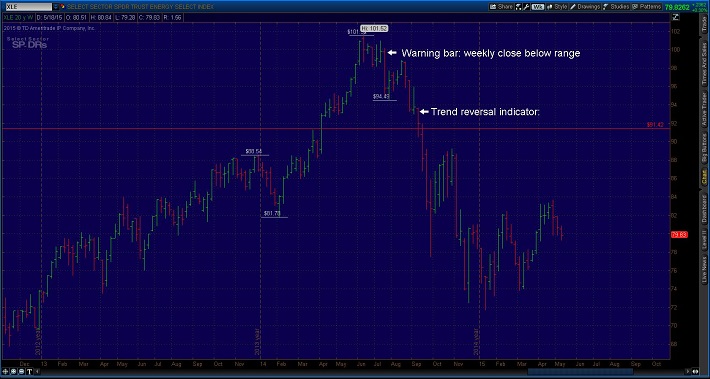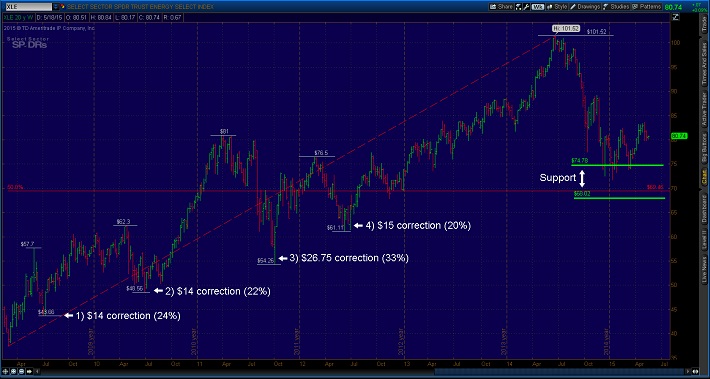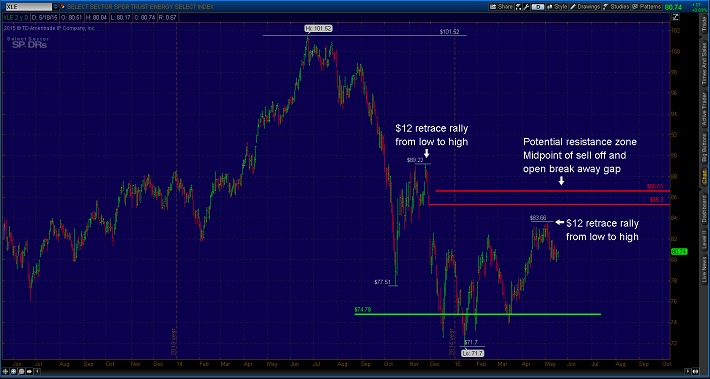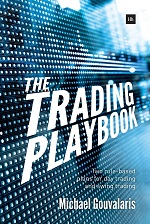The Trading Playbook: Swing Trading
Energy
A practical example of a method for
analyzing and swing trading energy markets. Guest post by Michael
Gouvalaris, author of The Trading Playbook: Two rule-based plans for day
trading and swing trading.
***
The
Trading Playbook was written for
traders of all levels who desire to learn a straightforward method of
analyzing the market and spotting quality support and resistance
levels. The book
is broken into two sections, one for day traders and
one for swing traders. Today we will focus on the Swing Trading
component as we break down the recent moves in the Energy sector, using
the Select SPDR etf XLE.
This methodology incorporates pattern
recognition in identifying support and resistance and the strength of
the trend. However this will be different from the chart
patterns you
typically see in traditional Technical Analysis books. The chart
patterns that we will be discussing are derived from supply and demand
only. As I find these to be more reliable in spotting
support/resistance
and analyzing the trend.

Fig
1: The Trading Playbook: Swing
Trading Energy
While in the midst of a bull market in
stocks that has lasted for six years, it can become increasingly
difficult to find certain sectors or individual stocks
that may be
trading at or below perceived fair
value. However due to the price of
Oil, which has fell some 60% since July 2014, the Energy sector has
garnered much attention recently so I figured this would be a good
market to use for an example.
This first chart above (Fig 1) shows
the price action in the Energy sector. In 2014 price broke above its
2008 highs (red horizontal line) to make a new all-time high. Price
continued
to advance about 10% higher before topping out at $101.52.
The first warning sign was a weekly close well below the low of the
prior trading range. These kinds of supply/demand shifts can be a
warning sign of a potential change in trend.
The rule
of thumb when these signals are generated, is to expect a
counter
trend move of AT LEAST the size of the most recent multi-bar
counter trend move (again specific to what time frame you are using).
In this case we are using the weekly bar chart, so the last multi-week
correction at that point took place in early 2014 and produced a
roughly $7 point drop in XLE. So if one was bullish XLE, one could buy
support around $95, which was $7 points down from its all-time highs
and coincided with a previous weekly swing high. It was good enough to
produce a retrace
rally back to the midpoint of the correction.
For the short trade, there wasn’t a
whole lot of opportunity left, as
the large red bar dropped right into the support target below. However
if one was still bearish on energy and anticipated a break
in the
uptrend, you would still place the trade (or short the
midpoint
retracement), keep your stop above the high of the signal
bar, and
watch what happened.
In this case, the short trade would have worked just fine as price
eventually made a new short term low and broke the uptrend pattern by
creating a counter trend move that was greater in size than the
previous.
 Fig 2: The
Trading Playbook: Corrections in the SPDR XLE Chart
Fig 2: The
Trading Playbook: Corrections in the SPDR XLE Chart
This chart (Fig 2) looks at the bigger
corrections since the market
bottom of 2009. We can look for additional patterns to come up with
some realistic expectations and anticipate future support. Here we see
that the energy sector has experienced four separate corrections since
2009. I have highlighted each one for reference. Three out of the four
corrections
were of the $14-$15 or 20%-24% variety while the biggest
correction came in 2011 and that equated to a $26.75 drop or about 33%.
So the next expectation for shorts
would be a continuation of selling
to take price down at least $14-$15 points below its swing high. This
proved to be a successful target for shorts but not such a great
support level to initiate new longs as sellers took complete control of
the trend. Of course the next target/support zone then came in just
below $75.
We now find ourselves in a position where the Energy sector has matched
the size (by $ amount) of the 2011 correction. I have highlighted this
price level ($74.78) as it’s the top green horizontal line. For now
price has stabilized around this level however in the event of further
weakness the next major area of support, as I see it, comes in around
the $68 – $69.50 area. The $68 price level would match the size of the
2011 correction in terms of percentages
(33%) and so I have highlighted
it as the bottom green horizontal line. While the $69.50 level happens
to be the midpoint of the entire bull
market run over the last 5 years
and it is represented as the red horizontal line on the chart.
Next we can gauge the level of demand that comes in off of support to
get an indication of whether the buyers will regain control of not.
 Fig 3: The
Trading Playbook: SPDR XLE Chart Support and Resistance
Fig 3: The
Trading Playbook: SPDR XLE Chart Support and Resistance
Now just like we gauged the counter trend movements as price was in an
uptrend, we can now do the same for the retrace rallies to spot
potential resistance and gauge the strength of the prevailing trend.
In the short term it looks as if the
retrace rally may be running into
some resistance.
The last retrace found support near the 2012 highs and
pushed prices back up $12 points before finding resistance and a new
low was formed in early 2015.
Over the next few months the Energy sector has been pushing higher as
Oil prices has gone from $40 to $60 dollars a barrel, for roughly a 50%
gain. Recently XLE has run into resistance as it has matched the $12
rally length of the previous retrace rally in late 2014. Add in some
confluence above at $85.30 (which happens to be the breakaway gap of
late November 2014) and $86.61 (which happens to be the midpoint of the
entire
bear market) as potential resistance points.
A failure by buyers to push prices higher and thus break the downside
momentum, likely means that prices will fall back down to at least
$77.50, which represents the last major swing low. This would also
setup for a price drop down to the lower support zone in the area of
$68 to 69.50.
So for short term traders, taking
profits would likely be the best
option available here. For investors, purchases in the support zone
sets up a good probability for growth over the long term.
###
Michael Gouvalaris is author of The Trading Playbook: Two rule-based
plans for day trading and swing trading.

The Trading Playbook: Two
rule-based plans for day trading and swing trading
Publisher: Harriman House
Published: 13 April 2015
Edition: 1st
Pages: 132
|